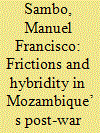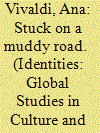| Srl | Item |
| 1 |
ID:
190932


|
|
|
|
|
| Summary/Abstract |
It has been about three decades since Mozambique transitioned from a brutal civil war and one-party rule to peace and democracy. Although Mozambique has not relapsed into another large-scale civil war, sustainable peace and democracy in the country have become ever more elusive. In 2013, military clashes between Renamo and the Frelimo-led government resumed and prompted a new peace process, whilst poverty and inequalities are rampant, authoritarianism is on the rise, and an Islamic insurgency erupted in the northern region. Accordingly, while some scholars still praise Mozambique’s post-war peacebuilding as successful, others have claimed that peacebuilding failed. This article evades the binary of successful or failed liberal peacebuilding in Mozambique. Instead, it applies the concepts of friction and hybridity to offer an alternative way of reading the 30 years of peace (building) in Mozambique. The article argues that frictions in values and interests between the international/liberal peacebuilders and local (non-liberal) elites have resulted in a negative and unstable hybrid peace, that is, a precarious peace in Mozambique.
|
|
|
|
|
|
|
|
|
|
|
|
|
|
|
|
| 2 |
ID:
113899


|
|
|
|
|
| Publication |
2011.
|
| Summary/Abstract |
This article explores how the Toba, an indigenous group in the North of Argentina, shape places and an urban subjectivity in the frictions of their mobility between villages, the urban barrio (neighborhood), and the periurban bush. I argue that the experience of Toba moving to the city is better understood as frictions between the Toba desire to progress in the city, the organization of difference in space, and their multiple movements "back" to the villages. In addition, I analyze their contemporary hunting trips, which take urban Toba to the nearby bush, as a mobility that shapes a form of indigeneity engaged with access to both the city center and the bush. This practice confronts them with ranch owners and police but reconnects the barrio and the bush by traversing them. If frictions emerge between forces that trigger movement and forces that slow that movement down, in the frictions of mobility the Toba have at once shaped their position in the city and overflowed its limits.
|
|
|
|
|
|
|
|
|
|
|
|
|
|
|
|